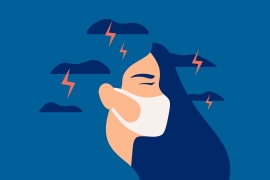
By Emily Dobson, Carol Graham, Tim Hua, Sergio Pinto
COVID-19 has justifiably raised widespread public concern about mental health worldwide. In the U.S., the pandemic was an unprecedented shock to society at a time when the nation was already coping with a crisis of despair and related deaths from suicides, overdoses, and alcohol poisoning. Meanwhile, COVID-19’s impact was inequitable: Deaths were concentrated among the elderly and minorities working in essential jobs, groups who up to the pandemic had been reporting better mental health. We still do not fully understand how the shock has affected society’s well-being and mental health.
In a recent paper in which we compared trends in 2019-2020 using several nationally representative datasets, we found a variety of contrasting stories. While data from the 2019 National Health Interview Survey (NHIS) and the 2020 Household Pulse Survey (HPS) containing the same mental health screening questions for depression and anxiety show that both increased significantly, especially among young and low-income Americans in 2020, we found no such changes when analyzing alternative depression questions that are also asked in a consistent manner in the 2019-2020 Behavioral Risk Factor Surveillance System (BRFSS) and the 2019-2020 NHIS. Despite the differences in trends, the basic determinants of mental health were similar in three data sets in the same two years.
Our findings raise questions about the robustness of the many studies claiming unprecedented increases in depression and anxiety among the young compared to older cohorts. Many of them, due to the urgency created by COVID-19 and a paucity of good, consistent data, matched datasets and used different questions therein in their attempt to identify changes in the trends between the two years. The inconsistency in the outcome changes over time across datasets points to the need for caution in drawing conclusions, as well as in relying too heavily on a single study; results generated from different data may differ considerably.
Given the paucity of comparable data and the usual one-year lag in the release of the final mortality data from the Centers for Disease Control and Prevention (CDC), we also tried to get a handle on changes in patterns in mental health by examining emergency medical services (EMS) data calls related to behavior, overdoses, suicide attempts, and gun violence. The EMS data has the advantage of using the same methods and samples over the two-year period. We found an increase in gun violence and opioid overdose calls in 2020 after lockdowns, but surprisingly, a sharp decrease in behavioral health calls and no change in suicide-related EMS activations. The latter trend is a puzzle, but possible explanations include opioid overdose deaths increasing markedly and possibly substituting for suicide deaths. Alternatively, many older men—who are the demographic groups with the most suicide deaths—died of COVID-19 in that same period; another tragic “substitution” effect.
Finally, we looked at whether over the long run there is a relationship between poor mental health and later deaths of despair in micropolitan and metropolitan statistical areas (MMSAs). We found modest support for that possibility. Based on mental health reports in the BRFSS and CDC mortality data, we find that two-to-three-year-lagged bad mental health days (at the individual level) are associated with higher rates of deaths of despair (at the MMSA level), and that the two-to-four-year-lagged rates of deaths of despair are associated with a higher number of bad mental health days in later years. We cannot establish a direction of causality, but it is possible that there are vicious circles at play with individual trends in mental health contributing to broader community distress, and communities with more despair-related deaths likely to have more mental health problems later as a result.
Our analysis, based on many different datasets and indicators of despair, does not contradict other studies in that despair is an ongoing problem in the U.S., as reflected by both mental health reports and trends in EMS activations. However, we do find that the effects of the COVID-19 pandemic are mixed, and that while some trends, such as opioid overdose deaths, worsened in 2020 compared to 2019, others, such as in some mental health reports and in suicide rates, improved slightly. Our work does not speak to the longer-term mental health consequences of the pandemic, but it does suggest that there were deep pockets of both despair and resilience throughout it. It also suggests that caution is necessary in drawing policy implications from any one study.










